Abstract
The fitting and modeling of skewed, complex, symmetric, and asymmetric datasets is an exciting research topic in many fields of applied sciences: notably, lifetime, medical, and financial sciences. This paper introduces a heavy-tailed Nadarajah Haghighi model by compounding the heavy-tailed family and Nadarajah Haghighi distribution. The model obtained has three parameters that account for the scale and shape of the distribution. The proposed distribution’s fundamental characteristics, such as the probability density, cumulative distribution, hazard rate, and survival functions, are provided, several key statistical properties are established, and several entropy information measures are proposed. Estimation of model parameters is performed via a maximum likelihood estimator procedure. Further, different simulation experiments are conducted to demonstrate the proposed estimator’s performance using measures like the average estimate, the average bias, and the associated mean square error. Finally, we apply our proposed model to analyze three different real datasets. In our illustration, we compare the practicality of the recommended model with several well-known competing models.
1. Introduction
In the last few decades, classical distributions have typically been found to lack fit in many areas of study, such as economics, actuarial science, engineering, environmental science, lifetime, medical science, and several others. Because of this, the authors have elaborated seriously on establishing several distinctive models adapted for specific datasets like symmetrical, asymmetrical, complex, and skewed datasets. This flexibility may be achieved by adding new factors to the classic distribution, including adding one or more parameters or making several transformations to the baseline distribution in order to increase its ability to handle complicated scenarios. In this context, numerous classes of distributions have been obtained by applying different procedures to reinforce the adaptability of models, thereby creating a more versatile and potent distribution for dataset modeling. These suggested families of distributions have an important efficiency in accepting various kinds of data sets, notably asymmetric, bi-modal, and right or left skewed datasets as well as provide greater flexibility for analyzing various applications: for examples, see the studies of Madhavi and Kundu [1], Alfaer er al. [2], Marshall and Olkin [3], Afify et al. [4], Meraou and Raqab [5], Ahmad et al. [6], Meraou el al. [7], Gemeay et al. [8], Amal S. Hassan et al. [9], Sapkota et al. [10], Cordeiro et al. [11], Teamah et al. [12], Bourguignon et al. [13], Yıldırım et al. [14], Meraou et al. [15], Almuqrin et al. [16], Zagrofos and Balakrishana [17], Kamal et al. [18], Teamah et al. [19], Eugene et al. [20], Alsadat et al. [21], Alzaatreh et al. [22], Nagy et al. [23], and Meraou et al. [24].
Recently, a novel class of distributions was provided by Ahmed et al. [25] called the heavy-tailed (HT) class of distributions. This new extension is an appropriate model for modeling HT, symmetric, complex, and skewed datasets, and it is a powerful method for generating new models to analyze datasets’ underlying patterns better. The HT class of distributions can portray several real–realistic application studies in many areas, notably hydrology, biology, agriculture, production, survival, and finance. The cdf and pdf of the HT family of distributions can be expressed, respectively, as follows:
and
where and represent respectively density and cumulative distribution of the baseline model. Now, the survival function (sf) with corresponding hazard rate function (hrf) of the proposed HT class of distributions are expressed, respectively, as
and
It is well documented that the Nadarajah Haghighi (NH) model is widely used in statistical modeling. It is an innovative extension of the exponential distribution that serves as an alternative model to the gamma and exponentiated–exponential distribution. The NH distribution was first introduced by Nadarajah and Haghighi [26], and it can be applied to fit several kinds of datasets—notably, skewed, complex, and heavy-tailed—and it can also be used in different fields of application, particularly in reliability and engineering. It is well-documented that the NH model can be extensively investigated in many study domains. Noteworthy studies involving this model include Almetwally and Meraou [27], Korkmaz et al. [28], Salama et al. [29], Almongy et al. [30], Tahir et al. [31], Lone et al. [32], Shafq et al. [33], and Anum Shafiq et al. [34]. The cdf and pdf of an NH distribution are formulated, respectively, as
and
where and represent the shape and scale parameters, respectively. These two parameters show the non-monotone shape of the hazard rate and the failure times of components and systems.
This research aims to enhance the NH distribution, resulting in a generalized distribution termed the heavy-tailed Nadarajah Haghighi model (HTNH). The model’s flexibility is obtained by a new additional shape parameter that defines its cumulative distribution function. The additional parameter plays an important role in analyzing the tail behavior of the proposed density function. Also, the newly added parameter efficiently models many reliability functions, such as the hazard rate function, and can be used to fit skewed datasets. This distribution can find a wide range of applications in analyzing business failure lifetime data, sizes of cities, income and wealth inequality, actuarial sciences, medical and biological sciences, engineering, lifetime, and reliability. The pdf of the proposed model can be decreased and skewed, and a sub-model can be obtained as a special case. Estimation of the model’s parameters is performed via the maximum likelihood estimator (MLE) and Bayes techniques. It is worth mentioning that the Bayesian method is performed via the square error loss function. Many applications for this method have been found by researchers, including Xu et al. [35], Almetwally et al. [36], Al-Babtain et al. [37], and Zhou et al. [38]. Further, we introduce a confidence interval (CI) for the model parameters by using the asymptotic distribution of the MLE procedure, and various entropy information measures are introduced.
The following factors were involved in the design of this paper. In Section 2, we define our HTNH model and established its distributional properties. Many mathematical properties of our proposed model are provided in Section 3. The final expressions of six proposed entropy information measures for the HTNH model are formulated in Section 4. Section 5 demonstrates the estimation of model parameters via the MLE technique, and the CIs of unknown parameters for our HTNH model are also constructed in this section. In Section 6, a Monte Carlo (MC) simulation analysis is illustrated to show the consistency and unbiasedness of the recommended estimator, and three real datasets are utilized to select the more appropriate distributions in Section 7. Finally concluding results are provided for this study in the last section.
2. The HTNH Model and Its Distributional Properties
In this part of the work, we consider certain distributional properties of the proposed HTNH model, including the cdf, pdf, sf, hrf, cumulative hrf (chrf), and reverse hrf (rhrf).
Theorem 1.
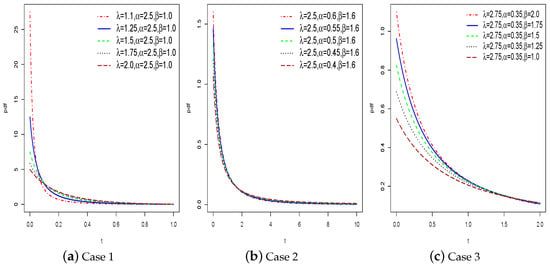
Let T be a random variable following the HTNH model with parameters λ, α, and β ( HTNH). According to Equations (1) and (5), the cdf and pdf of T are obtained, and they are expressed, respectively, as follows:
and
The limiting behavior of the pdf of the recommended HTNH model if and can be expressed as
Consequently, for all parameter values of λ, α, and β, the pdf of the HTNH distribution is decreasing.
Under Equation (7), the HT exponential (HTE) distribution can be obtained as a special case when α = 1. Figure 1 depicts a few of the most likely contours of the pdf using several parameter values of HTNH distribution. In all situations, the pdf of the suggested HTNH model is decreasing and is positively skewed.

Figure 1.
A graphical illustration of pdf of the Possible pdf HTNH model.
Theorem 2.
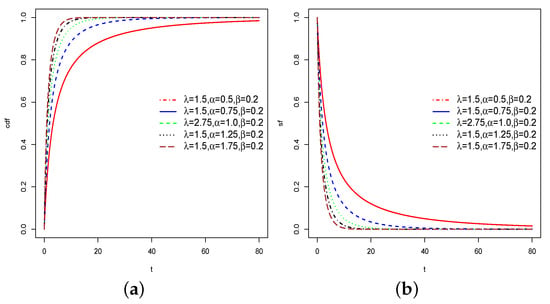
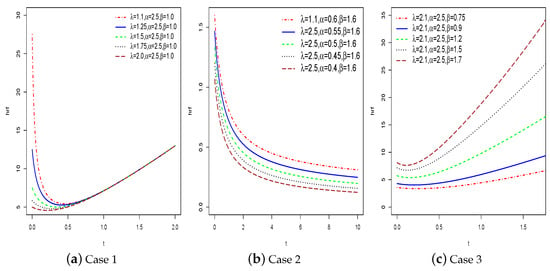
The sf and hrf of T are structured, respectively, by
and
The plots of the cdf and sf of the HTNH model are sketched in Figure 2, while Figure 3 depicts the graphs of the hrf curves of the proposed HTNH distribution. From Figure 3, the hrf of the HTNH distribution has different forms. It is increase, decrease, and J-forms curves. Consequently, it can be deduced that our HTNH distribution is and efficient model in analyzing numerous types of datasets.

Figure 2.
A graphical illustration of cdf and sf of the HTNH model: (a) cdf; (b) sf.

Figure 3.
A graphical illustration of hrf of the HTNH model.
Theorem 3.
The chrf and rhrf of the HTNH model are written, respectively, as
and
3. Statistical Properties of HTNH Model
In this part of the study, we establish several mathematical properties of the proposed HTNH model. In this subsection, let us consider .
3.1. Identifiability Property
The parameter is applied to provide the identifiability property of the proposed HTNH model, which is useful for making precise inferences. Suppose that and follow the cdf as described in (7). The parameter is identifiable if . As a result,
3.2. Quantile Function
Theorem 4.
The quantile function of T can be formulated by
Using the above equation, a random sample from our suggested HTNH model may be generated with q following a uniform random number (0,1), which will be useful for further development.
The coefficients for the skewness () and kurtosis () of T can be formulated, respectively, as
and
3.3. Useful Expansion
The expansion of the proposed pdf of the HTNH model is
where and are given in Equations (5) and (6), respectively.
For simplicity, we utilize the negative binomial series:
Now, by taking and , we obtain
The pdf of the recommended HTNH model can be rewritten as
By substituting and as the cdf and pdf, respectively, of the NH distribution, the pdf of the proposed HTNH model is defined by Equation (10). It is given by
Similarly, the cumulative distribution of the recommended HTNH model is rewritten as
Using a negative binomial series with
the cdf of the proposed HTNH model can be rewritten as
By substituting and as the cdf and pdf, respectively, of NH distribution, the cdf of the proposed HTNH model is defined by Equation (11). It can be written as
3.4. Moment and Related Measures
Theorem 5.
The corresponding moment of T is
where .
Furthermore, the variance and index of dispersion for T are
and
Theorem 6.
Based on [39], the moment-generating function (mgf) is presented as follows:
Theorem 7.


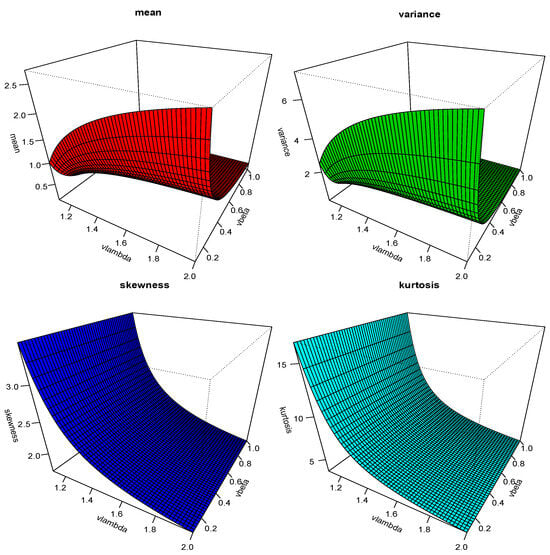
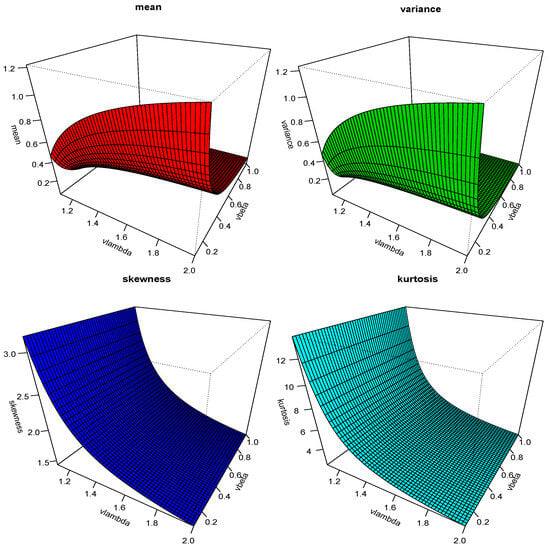
The corresponding characteristic function (cf) of T is
Table 1 and Table 2 represent several suggested statistical properties of the HTNH model, like , variance, ID, , and , which are also displayed in Figure 4 and Figure 5.

Table 1.
Various mathematical properties for the HTNH distribution at .

Table 2.
Various mathematical properties for the HTNH distribution at .

Figure 4.
3 dimension plot of the statistical properties at .

Figure 5.
3 dimension plot of the statistical properties at .
3.5. Residual and Reverse Residual Life
Theorem 8.
Let T be a random variable that follows the HTNH model. The residual reliability function of Y, abbreviated as , can be defined as
Theorem 9.
The reverse residual reliability function of Y, abbreviated as , is
3.6. The Pdf and Cdf of the Order Statistics of the HTNH Model
Assume that is a random sample taken from the HTNH distribution, and represents its order statistics. Further, the pdf of is
The corresponding cdf of can be provided as
Hence, the pdfs of the and , defined, respectively, as and , are written as
and
4. Certain Entropy Measures
This subsection considers numerous information entropy measures: notably, Rényi, Shannon, Havrda and Charvat, Tsallis, Arimoto, and Mathai–Haubold.
First, we started with the Rényi [40] ) entropy of our HTNH model. The Renyi entropy is a measure of uncertainty in information theory. It is formulated by
with .
The Shannon entropy is another information uncertainty measure. It is simply the “amount of information” in a variable, defined as
Next, we consider the novel Havrda and Charvat entropy [41] () of the proposed HTNH distribution in this work. The Havrda and Charvat entropy represents a parametric extension of the Shannon entropy. We propose to use this information to get a better grasp on all sorts of data.
It is presented as
The Tsallis entropy [42] (also used bu Ibrahim [43]) is proportional to the expectation of the -logarithm of the HTNH distribution. It can be written as
Further, we express the Arimoto entropy [44] () of the HTNH model, which is a generalization of the Shannon entropy. It is a similarity metric used to measure statistical dependence. It can be examined by
In the end, a novel flexible information called the Mathai–Haubold entropy [45] () is established. It can be used in residual lifetime and engineering applications. It can be defined as follows:
Table 3 and Table 4 summarize certain information entropy measures of the HTNH model as discussed in this section using several selected parameters of , , and . Further, Figure 6 and Figure 7 depict the 3D curves of these information entropy measures. It is clear from the results in Table 3 and Table 4 that:

Table 3.
Various information entropy for the HTNH distribution at and .

Table 4.
Various information entropy for the HTNH distribution at and .
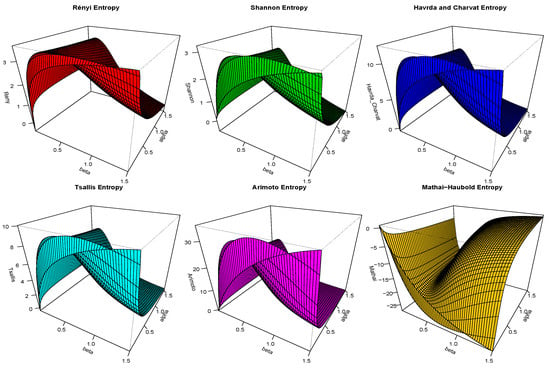
Figure 6.
3 dimensions plots of the recommended information measures with and .
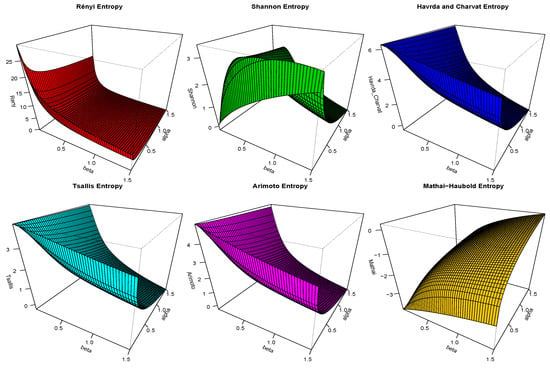
Figure 7.
3 dimensions plots of the recommended information measures with and .
- When increases and and are fixed, the values of and tend to decrease, whereas the value of increases.
- When increases and and are fixed, we obtain the same results.
- Finally, if increases, the values of and increase, but the values of and decrease.
- The HTNH model has a great role in modeling different fields of datasets.
5. Statistical Inference
In this section, we introduce different estimator techniques for determining the estimate parameters of our proposed model.
5.1. Maximum Likelihood Estimator
Assume that is a random sample drawn from our HTNH model of size n, and let denote the parameter vector. The log-likelihood function of our model can be written as follows:
Equations (14)–(16) describe non-linear equations that are tricky to write concisely, rendering it difficult to solve them directly for the vector parameter . Iterative approaches, notably fixed-point, secant, and Newton–Raphson methods, are employed. The aforementioned methods enable quicker determination of the MLE of . We note that all obtained estimates of the proposed HTNH distribution exist and are unique.
5.2. Approximate Confidence Interval
Now to construct the confidence intervals (CIs) of the parameters, by applying the idea of Louis [46], the asymptotic distribution of the MLE of is described as
with denotes the inverse of the matrix of . The elements of are
Finally, with , , and , the CI of are
and
where LCL is the lower confidence limit, UCL is the upper confidence limit, is the upper quantile of the standard normal distribution, .
Please see the elements of matrix in Appendix A.
5.3. Bayesian Estimator
We suppose that the parameters , , and are random variables that have, respectively, the prior pdf gamma distribution, and they are written as follows:
and
The joint density is
Further, the posterior density of , , , and the complete samples is given by
With , the Bayes estimator of the function of parameters based on the square error (SE) loss function
is written as
6. Simulation Experiments
We performed Monte Carlo (MC) simulation experiments in this subsection to demonstrate the potential of the MLE and Bayes methods of our suggested HTNH model using several sample sizes and numerous selected values of parameters of (), including Case1 = , Case2 = , Case3 = , and Case4 = ). By utilizing Equation (9), random numbers were generated by applying the following expression:
- Generate from Uniforme(0,1).
- Generate t as
Consequently, with 1000 repetitions of the process, we calculated certain measures, including the average estimate (AE), the average bias (AB), and the average mean square error (MSE). These findings are summarized in Table 5, Table 6, Table 7 and Table 8. A noteworthy trend emerges from the values in Table 5, Table 6, Table 7 and Table 8 as the sample size grows: the AEs tend to the actual values of parameters, and the ABs and MSEs exhibit a reduction for all parameter sets for the two proposed estimation procedure. This observation underscores the consistency and unbiasedness of the Bayes and MLE techniques for accurately estimating parameters within the HTNH model. Also, for comparison and by taking the MSE as an optimality criterion, the Bayes technique performs better than the MLE method. Further, we derived different CI estimates for the unknown parameters , , and . We computed the 95% simulated CIs using the associated average lengths (ALs) and coverage probabilities (CPs). The results are reported in Table 5, Table 6, Table 7 and Table 8. It can be seen that as the true values of and increase, the ALs of the CIs for all parameters based on all the proposed estimators increase.

Table 5.
The AEs, ABs, and MSEs of the HTNH model for Case 1.

Table 6.
The AEs, ABs, and MSEs of the HTNH model for Case 2.

Table 7.
The AEs, ABs, and MSEs of the HTNH model for Case 3.

Table 8.
The AEs, ABs, and MSEs of the HTNH model for Case 4.
7. Dataset Analysis
This segment focuses on appraising the effectiveness of the proposed HTNH distribution using three real datasets. We chose these datasets according to their utility and efficacy in survival and medical fields.
7.1. First Dataset
This dataset defines the healing times for bladder cancer patients. It is developed from Cordeiro et al. [47], Abouelmagd et al. [48]. Table 9 reported the values iofthe dataset.

Table 9.
The remissiontimes for bladder cancer patients.
7.2. Second Dataset
This dataset represents Kevlar 373/epoxy submissive to an incessant 90% stress scale. It is available from Andrews and Herzberg [49]. Table 10 summarized the records of the recommended dataset.

Table 10.
The values of the second dataset.
7.3. Third Dataset
This dataset defines the infant mortality rate per 1000 live births in 1 January 2021. The suggested data sets is available in https://data.worldbank.org/indicator/SP.DYN.IMRT.IN, and it has been studied by Chinedu et al. [50]. The values of this dataset are recorded in Table 11.

Table 11.
The values of the infant mortality rates per 1000 live births.
Table 12 represents the description statistics of the three suggested datasets, and the kernel densities, TTTs, and box plots for the observed datasets are drawn in Figure 8.

Table 12.
Summary statistic measures for the three datasets considered.
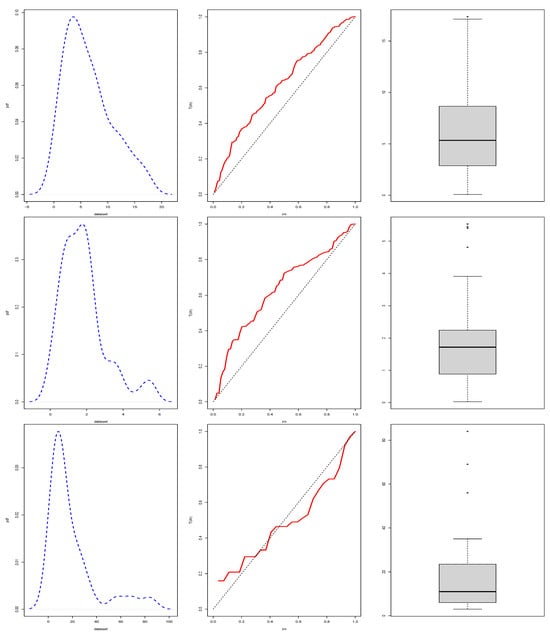
Figure 8.
Non-parametric plots of the three proposed datasets.
Furthermore, to enable comparisons, the HTNH model was fitted against several alternative models. These models include the Burr power inverse Nadarajah Haghighi (PINH), Nadarajah Haghighi (NH), heavy-tailed exponential (HTE), Sin Nadarajah Haghighi (SNH), and alpha power transformed exponential (APTE) models.
Table 13 displays the results of the estimated parameter values with their corresponding log-likelihood functions (. In the evaluation process, specific metrics are employed to ascertain the most robust model among the contenders. This involves utilizing well-established criteria, notably Bayesian information criterion (), Kolmogorov–Smirnov () statistics with their associated -values, and Akaike information criterion (). Among the competing models, the one exhibiting the lowest values for these indicators is regarded as the most appropriate choice. As a result, according to the values in Table 13, we can conclude that the HTNH model is more appropriate for modeling the three datasets considered. Figure 9, Figure 10 and Figure 11 discuss the fitted density and cdf curves of the fittings for the proposed distributions. Clearly, from these figures, the plots of estimated pdfs for the suggested HTNH distribution are approximated to their corresponding kernel densities for all of the proposed datasets. Consequently, all these figures demonstrate that our HTNH model fits the three considered datasets well.

Table 13.
MLEs and numerous indicator statistics comparison using three proposed datasets.
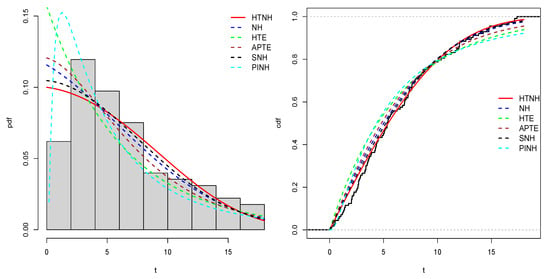
Figure 9.
The pdf and cdf estimate plots for the fitting distributions using the first dataset.
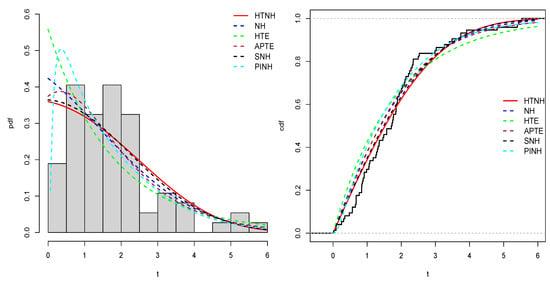
Figure 10.
The pdf and cdf estimate plots for the fitting distributions using the second dataset.
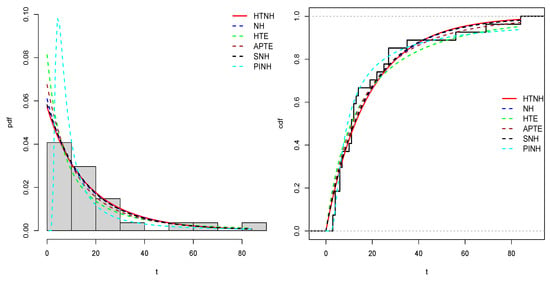
Figure 11.
The pdf and cdf estimate plots for the fitting distributions using the third dataset.
8. Concluding Remarks
This research delves into a novel method employing the heavy-tailed function and then applying it to the Nadarajah Haghighi distribution. The new and adaptable model is named the heavy-tailed Nadarajah Haghighi model and is designated as HTNH. The focus lies in establishing several mathematical properties associated with this model. Estimation of model parameters is facilitated by employing the MLE procedure. For simulation analysis, we conducted some simulation experiment studies to demonstrate the performance of the proposed MLE method. Finally, three real datasets were used to check our proposed model’s applicability. This comprehensive exploration signified that the HTNH model offered an improved fit for the three suggested datasets, as illustrated by the collected empirical results in the simulation part.
Author Contributions
Methodology, M.A., H.M.A. and M.M.A.; software, M.A.M.; validation, F.H.R.; formal analysis, M.A., S.M.A.A. and F.H.R.; investigation, M.M.A.; writing—original draft preparation, F.M.A.; writing—review and editing, E.A. All authors have read and agreed to the published version of the manuscript.
Funding
Princess Nourah bint Abdulrahman University Researchers Supporting Project number (PNURSP2024R735), Princess Nourah bint Abdulrahman University, Riyadh, Saudi Arabia.
Data Availability Statement
All data exists in the paper with related references.
Acknowledgments
Princess Nourah bint Abdulrahman University Researchers Supporting Project number (PNURSP2024R735), Princess Nourah bint Abdulrahman University, Riyadh, Saudi Arabia.
Conflicts of Interest
The authors declare no conflicts of interest.
Appendix A
The elements of matrix are given as
References
- Mahdavi, A.; Kundu, D. A new method for generating distributions with an application to exponential distribution. Commun. Stat.-Theory Methods 2017, 46, 6543–6557. [Google Scholar] [CrossRef]
- Alfaer, N.M.; Gemeay, A.M.; Aljohani, H.M.; Afify, A.Z. The extended log-logistic distribution: Inference and actuarial applications. Mathematics 2021, 9, 1386. [Google Scholar] [CrossRef]
- Marshall, A.W.; Olkin, I. A new method for adding a parameter to a family of distributions with application to the exponential and Weibull families. Biometrika 1997, 84, 641–652. [Google Scholar] [CrossRef]
- Afify, A.; Gemeay, A.; Ibrahim, N. The heavy-tailed exponential distribution: Risk measures, estimation, and application to actuarial data. Mathematics 2020, 8, 1276. [Google Scholar] [CrossRef]
- Meraou, M.A.; Raqab, M.Z. Statistical properties and different estimation procedures of Poisson Lindley distribution. J. Stat. Theory Appl. 2021, 20, 33–45. [Google Scholar] [CrossRef]
- Ahmad, A.; Alsadat, N.; Atchade, M.N.; ul Ain, S.Q.; Gemeay, A.M.; Meraou, M.A.; Almetwally, E.M.; Hossain, M.M.; Hussam, E. New hyperbolic sine-generator with an example of Rayleigh distribution: Simulation and data analysis in industry. Alex. Eng. J. 2023, 73, 415–426. [Google Scholar] [CrossRef]
- Meraou, M.A.; Al-Kandari, N.; Raqab, M.Z. Univariate and bivariate compound models based on random sum of variates with application to the insurance losses data. J. Stat. Theory Pract. 2022, 16, 1–30. [Google Scholar] [CrossRef]
- Gemeay, A.M.; Karakaya, K.; Bakr, M.E.; Balogun, O.S.; Atchadé, M.N.; Hussam, E. Power Lambert uniform distribution: Statistical properties, actuarial measures, regression analysis, and applications. AIP Adv. 2023, 13, 095319. [Google Scholar] [CrossRef]
- Amal, H.; Said, G.N. The inverse Weibull-G family. J. Data Sci. 2018, 16, 723–742. [Google Scholar] [CrossRef]
- Sapkota, L.P.; Kumar, V.; Gemeay, A.M.; Bakr, M.E.; Balogun, O.S.; Muse, A.H. New Lomax-G family of distributions: Statistical properties and applications. AIP Adv. 2023, 13, 095128. [Google Scholar] [CrossRef]
- Cordeiro, R.; Pulcini, G. A new family of generalized distributions. J. Stat. Comput. Simul. 2011, 81, 883–893. [Google Scholar] [CrossRef]
- Teamah, A.E.A.; Elbanna, A.A.; Gemeay, A.M. Heavy-tailed log-logistic distribution: Properties, risk measures, and applications. Stat. Optim. Inf. Comput. 2021, 9, 910–941. [Google Scholar] [CrossRef]
- Bourguignon, M.; Silva, R.B.; Cordeiro, G.M. The Weibull-G family of probability distributions. J. Data Sci. 2014, 12, 53–68. [Google Scholar] [CrossRef]
- Yıldırım, E.; Ilıkkan, E.S.; Gemeay, A.M.; Makumi, N.; Bakr, M.E.; Balogun, O.S. Power unit Burr-XII distribution: Statistical inference with applications. AIP Adv. 2023, 13, 105107. [Google Scholar] [CrossRef]
- Meraou, M.A.; Al-Kandari, N.; Raqab, M.Z.; Kundu, D. Analysis of skewed data by using compound Poisson exponential distribution with applications to insurance claims. J. Stat. Comput. Simul. 2021, 92, 928–956. [Google Scholar] [CrossRef]
- Almuqrin, M.A.; Gemeay, A.M.; El-Raouf, M.A.; Kilai, M.; Aldallal, R.; Hussam, E. A flexible extension of reduced kies distribution: Properties, inference, and applications in biology. Complexity 2022, 2022, 1–9. [Google Scholar] [CrossRef]
- Zagrafos, K.; Balakrishnan, N. On families of beta-and generalized gamma-generated distributions and associated inference. Stat. Methodol. 2009, 6, 344–362. [Google Scholar] [CrossRef]
- Kamal, M.; Atchadé, M.N.; Sokadjo, Y.M.; Hussam, E.; Gemeay, A.M.; Almulhim, F.A.; Alharthi, A.S.; Aljohani, H.M. Statistical study for Covid-19 spread during the armed crisis faced by Ukrainians. Alex. Eng. J. 2023, 78, 419–425. [Google Scholar] [CrossRef]
- Teamah, A.E.; Elbanna, A.A.; Gemeay, A.M. Right truncated fréchet-weibull distribution: Statistical properties and application. Delta J. Sci. 2019, 41, 20–29. [Google Scholar] [CrossRef]
- Eugene, N.; Lee, C.; Famoye, F. Beta-normal distribution and its applications. Commun. Stat.-Theory Methods 2002, 31, 497–512. [Google Scholar] [CrossRef]
- Alsadat, N.; Hassan, A.S.; Gemeay, A.M.; Chesneau, C.; Elgarhy, M. Different estimation methods for the generalized unit half-logistic geometric distribution: Using ranked set sampling. AIP Adv. 2023, 13, 085230. [Google Scholar] [CrossRef]
- Alzaatreh, A.; Lee, C.; Famoye, F. A new method for generating families of continuous distributions. Metron 2013, 71, 63–79. [Google Scholar] [CrossRef]
- Nagy, M.; Almetwally, E.M.; Gemeay, A.M.; Mohammed, H.S.; Jawa, T.M.; Sayed-Ahmed, N.; Muse, A.H. The new novel discrete distribution with application on covid-19 mortality numbers in Kingdom of Saudi Arabia and Latvia. Complexity 2021, 2021, 1–20. [Google Scholar] [CrossRef]
- Meraou, M.A.; Raqab, M.Z.; Kundu, D.; Alqallaf, F. Inference for compound truncated Poisson log-normal model with application to maximum precipitation data. Commun. Stat.-Simul. Comput. 2024, 1–22. [Google Scholar] [CrossRef]
- Ahmad, Z.; Mahmoudi, E.; Dey, S. A new family of heavy-tailed distributions with an application to the heavy-tailed insurance loss data. Commun. Stat. Simul. Comput. 2020, 51, 4372–4395. [Google Scholar] [CrossRef]
- Nadarajah, S.; Haghighi, F. An extention of the exponential distribution. J. Theor. Appl. Stat. 2011, 45, 543–558. [Google Scholar]
- Almetwally, E.A.; Meraou, M.A. Application of environmental data with new extension of nadarajah haghighi distribution. Comput. J. Math. Stat. Sci. 2022, 1, 26–41. [Google Scholar] [CrossRef]
- Korkmaz, M.C.; Yousof, H.M.; Hamedani, G.G. Topp-Leone Nadrajah-Haghighi distribution mathematical properties and applications. Stat. Actuar. Sci. 2017, 2, 119–128. [Google Scholar]
- Salama, M.M.; El-Sherpieny, E.S.A.; Abd-elaziz, A.E.A. The length-biased weighted exponentiated inverted exponential distribution: Properties and estimation. Comput. J. Math. Stat. Sci. 2023, 2, 181–196. [Google Scholar] [CrossRef]
- Almongy, H.M.; Almetwally, E.M.; Haj Ahmad, H.; Al-nefaie, A.H. Modeling of COVID-19 vaccination rate using odd Lomax inverted Nadarajah-Haghighi distribution. PLoS ONE 2022, 17, 0276181. [Google Scholar] [CrossRef]
- Tahir, M.H.; Gauss, M.; Cordeiro, S.A.; Sanku, D.; Aroosa, M. The inverted Nadrajah-Haghighi distribution estimation methodes and applications. J. Stat. Comput. Simul. 2018, 88, 2775–2798. [Google Scholar] [CrossRef]
- Lone, S.A.; Anwar, S.; Sindhu, T.N.; Jarad, F. Some estimation methods for the mixture of extreme value distributions with simulation and application in medicine. Results Phys. 2022, 37, 105496. [Google Scholar] [CrossRef]
- Shafq, S.; Helal, T.S.; Elshaarawy, R.S.; Nasiru, S. Study on an Extension to Lindley Distribution: Statistical Properties, Estimation and Simulation. Comput. J. Math. Stat. Sci. 2022, 1, 1–12. [Google Scholar] [CrossRef]
- Shafiq, A.; Lone, S.A.; Sindhu, T.N.; El Khatib, Y.; Al-Mdallal, Q.M.; Muhammad, T. A New Modified Kies Fréchet Distribution: Applications of Mortality Rate of COVID-19. Results Phys. 2022, 28, 104638. [Google Scholar] [CrossRef] [PubMed]
- Xu, A.; Wang, B.; Zhu, D.; Pang, J.; Lian, X. Bayesian reliability assessment of permanent magnet brake under small sample size. IEEE Trans. Reliab. 2024; Early Access. [Google Scholar] [CrossRef]
- Almetwally, E.M.; Alotaibi, R.; Mutairi, A.A.; Park, C.; Rezk, H. Optimal plan of multi-stress–strength reliability Bayesian and non-Bayesian methods for the alpha power exponential model using progressive first failure. Symmetry 2022, 14, 1306. [Google Scholar] [CrossRef]
- Al-Babtain, A.A.; Elbatal, I.; Almetwally, E.M. Bayesian and non-Bayesian reliability estimation of stress-strength model for power-modified Lindley distribution. Comput. Intell. Neurosci. 2022, 2022, 1154705. [Google Scholar] [CrossRef] [PubMed]
- Zhou, S.; Xu, A.; Tang, Y.; Shenn, L. Fast Bayesian inference of reparameterized gamma process with random effects. IEEE Trans. Reliab. 2024, 73, 399–412. [Google Scholar] [CrossRef]
- Simsek, B. Formulas derived from moment generating functions and Bernstein polynomials. Appl. Anal. Discret. Math. 2019, 13, 839–848. [Google Scholar] [CrossRef]
- Rényi, A. On Measures of Entropy and Information. In Proceedings of the Fourth Berkeley Symposium on Mathematical Statistics and Probability, Volume 1: Contributions to the Theory of Statistics; University of California Press: Berkeley, CA, USA, 1961; pp. 547–561. [Google Scholar]
- Havrda, J.; Charvat, F.S. Quantification method of classification processes: Concept of structural-entropy. Kybernetika 1967, 3, 30–35. [Google Scholar]
- Tsallis, C. Possible generalization of Boltzmann-Gibbs statistics. J. Stat. Phys. 1988, 52, 479–487. [Google Scholar] [CrossRef]
- Ibrahim, R. Water Engineering Modeling Controlled by Generalized Tsallis Entropy. Montes Taurus J. Pure Appl. Math. 2021, 3, 227–237. [Google Scholar]
- Arimoto, S. Information-theoretical considerations on estimation problems. Inf. Control. 1971, 19, 181–194. [Google Scholar] [CrossRef]
- Mathai, A.M.; Haubold, H.G. On generalized distributions and pathways. Phys. Lett. 2008, 372, 2109–2113. [Google Scholar] [CrossRef]
- Louis, T.A. Finding the observed information matrix when uisng the EM algorithm. J. R. Stat. Soc. Ser. B 1982, 44, 226–233. [Google Scholar] [CrossRef]
- Cordeiro, G.M.; Afify, A.Z.; Yousof, H.M.; Pescim, R.R.; Aryal, G.R. The exponentiated Weibull-H family of distributions: Theory and applications. Mediterr. J. Math. 2017, 14, 1–22. [Google Scholar] [CrossRef]
- Abouelmagd, M.; Al-mualim, S.; Afify, A.; Munir, A.; Al-Mofleh, H. The odd Lindley Burr XII distribution with applications. Pak. J. Stat. 2018, 34, 15–32. [Google Scholar]
- Andrews, D.F.; Herzberg, A.M. Stress-rupture life of kevlar 49/epoxy spherical pressure vessels. In Data; Springer: New York, NY, USA, 1985; pp. 181–186. [Google Scholar]
- Chinedu, E.Q.; Chukwudum, Q.C.; Alsadat, N.; Obulezi, O.J.; Almetwally, E.M.; Tolba, A.H. New Lifetime Distribution with Applications to Single Acceptance Sampling Plan and Scenarios of Increasing Hazard Rates. Symmetry 2023, 15, 1881. [Google Scholar] [CrossRef]
Disclaimer/Publisher’s Note: The statements, opinions and data contained in all publications are solely those of the individual author(s) and contributor(s) and not of MDPI and/or the editor(s). MDPI and/or the editor(s) disclaim responsibility for any injury to people or property resulting from any ideas, methods, instructions or products referred to in the content. |
© 2024 by the authors. Licensee MDPI, Basel, Switzerland. This article is an open access article distributed under the terms and conditions of the Creative Commons Attribution (CC BY) license (https://creativecommons.org/licenses/by/4.0/).